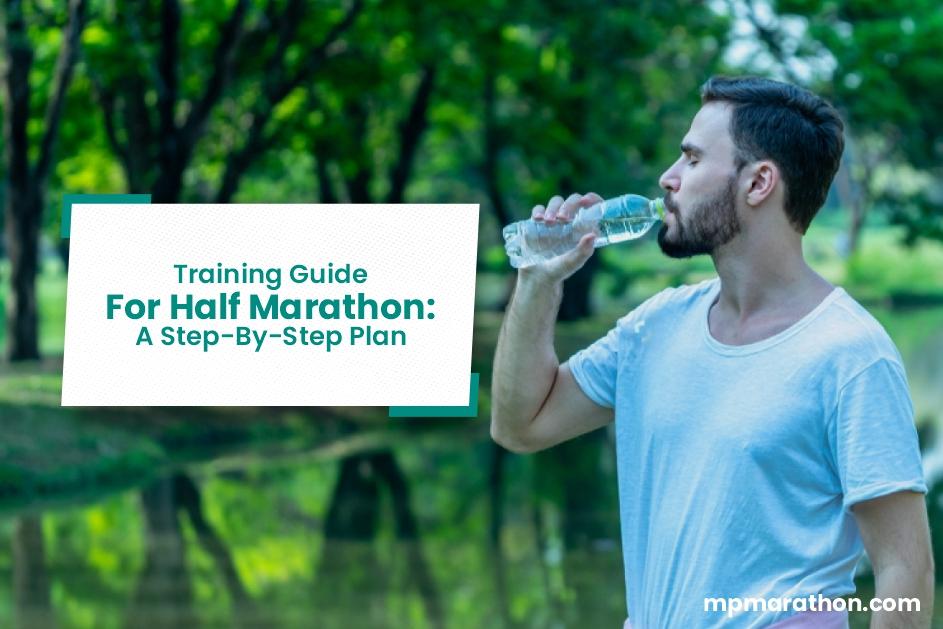Training Guide For Half Marathon: A Step-By-Step Plan
By
Tarishi Shrivastava
Dec 19, 2022

Half marathon training is a long-term investment. Make sure that you are doing everything right to ensure a successful race.
In this blog post, we will talk about the plan of action for training for a half marathon, provide tips on what to wear and eat for your race, and explain when and how long you should run before your half marathon.
As you can see, training for a half marathon is not as difficult as you think- following our recommended steps, you are guaranteed to be ready for the MP marathon in perfect shape!
How Should I Start The Training?
A successful half marathon is a great accomplishment, but it is not easy. That is why it is essential to start training correctly from the get-go. If you are new to the sport, consider training for shorter races first. Then, once you are comfortable with the process, it is time to start training for your half marathon. A training plan will help you target your specific goals and track your progress. Make plenty of breaks throughout your workout routine to avoid getting injured. And, of course, have fun! Half marathon training can be a lot of fun if done correctly.
How To Choose The Right Half Marathon Training Plan?
Training for a half marathon can be daunting, but it can be a rewarding experience with the right plan. The first step should be choosing the distance you want to train for. If you are new to half marathon training, start with a shorter distance, like the 5k or 10k. Once you have chosen your distance, determine your training schedule – weekly, monthly, or quarterly plans are all common options. Next, make sure to include running and cross-training sessions in your plan. This will work both the body and the mind simultaneously. Lastly, track your progress with a half-marathon training log to stay accountable.
Right Clothes For A Half Marathon?
Training for a half marathon is long and arduous, but it is worth it. To get started, make sure to wear running clothes that are comfortable and allow for plenty of movement. When training, aim at least 10-12 miles per week on soft surfaces like grass or sand. Make sure the clothing you choose is sweat-resistant and has ventilation – this will help keep you cool and comfortable during your runs. You may also want to carry electrolyte replacement drinks with you in case of dehydration. Finally, make sure to plan your training schedule carefully so that you reach your half-marathon goal successfully.
Diet Routine During A Half Marathon?
Training for a half marathon can be tiring and long, but it is important to ensure you are eating the right things to help you along the way. Aim to eat about 2,000 calories daily, including carbs and protein. You can also consume water and electrolytes to avoid dehydration or cramping. Make sure to train regularly, but gradually increase your distance and intensity over time, so you do not overdo it on race day. Finally, remember to hydrate well before and during the race by drinking plenty of fluids and consuming electrolytes like sodium and potassium.
4. Cross-Training Is The Key
Cross-training is the key to success in marathon running. By regularly incorporating other forms of exercise into your routine, your body will get used to the stress and strain of running a marathon. This way, you reduce the risk of injury and increase your chances of reaching your goals. There are plenty of ways you can cross-train - swimming, biking, elliptical trainers, etc. So make sure you find one that best suits your needs and schedule time for it every week!
How To Be Hydration For A Half Marathon?
The half marathon can be tough but worth it in the long run. To make the training process as effective as possible, it is important to drink enough fluids. Most runners need around 8-10 glasses of water per day. Still, this number can vary depending on your fitness level and race distance. It is also important to avoid sugary drinks and alcohol. Ensure your body gets all the nutrients. Eat foods that provide energy and fuel for running, like carbohydrates and protein. Stay hydrated and fueled up, and you are ready for race day!
How To Avoid Any Injury When Training For A Half Marathon?
The right training plan and precautions can be a great experience. The first step is to get a training plan that fits your needs and goals. Make sure the plan is challenging but doable – you do not want it to be too hard or too easy. Always start slowly and build up the intensity over time, following the guidelines of your specific race. Finally, wear properly fitted running shoes and clothing that would not cause injury when running in cold weather.
How To Prepare For A Long Run?
Training for a half marathon is long and arduous, but it is definitely worth it. Gradually increase your mileage over a few weeks to prepare for the race. This will help you build endurance and speed. Additionally, include interval training in your routine - this will help you improve endurance and speed while also burning fat. Taking breaks every couple of miles is also important for maintaining energy levels, preventing injury, and avoiding Overtraining Syndrome. Lastly, eat plenty of carbohydrates and protein as fuel sources before your long run. Training for a half marathon is a long, arduous journey that requires patience, determination and, most importantly, good training habits. You must pace yourself to make the most of your training and not overtrain. This means gradually cutting back on mileage leading up to the race. It is time to stop if you run too fast or too hard. The best way to train for a half marathon is by running shorter distances consistently. This way, your body gets used to the mileage, and you are in for a smooth race experience. Make sure to listen to your body – if it feels like you are going too fast or too hard, stop!
The Final Say
Congratulations on your upcoming half marathon! Now you know how to train your body for a half-marathon, the next step is to find the right plan and training schedule that works best for you. By following the steps listed above, you will be on your way to a successful run. Consult your doctor before training for a half marathon to ensure you are healthy enough to run this distance. We hope you enjoy the training plan we have put together for you!
FAQs
1. The best time of year to start training for a half marathon?
If you are thinking of training for a half marathon in the winter, be prepared to endure long runs and cold weather. Spring is a great time to train as it is usually milder, and there are fewer rain chances. Summer can also be a good time to start training as the humidity levels are lower, making running more comfortable. Autumn is perfect for those who want an intense workout but do not have much free time - this season offers shorter days that make workouts more challenging.
2. Should I run on a treadmill or outdoors?
Running outdoors is a great exercise for your body and mind, but if you are scared of the cold or do not have enough space to run outside, treadmill running may be a better fit. Running releases endorphins in your body, making you feel happy and relaxed. In addition, treadmill running takes less time than running on the streets or grass, which means that it is more practical for those with a busy schedule.
3. What are some good running routes for training for a half marathon?
1. Run long and hard-on long running routes that take about 30-45 minutes. Running on hills is excellent for improving your stamina and building up endurance. Hills force your body to use more energy and help you to run faster.
2. Try running on cycle paths or parks near your home. Running on these surfaces is a perfect way to work on your agility and balance, both of which are essential for a half-marathon race. Running in parks also allows you to run in a peaceful and scenic environment.
Search
Recent Blog Posts
Tags
bhopal half marathon
marathon in bhopal
upcoming marathon in bhopal
half marathon
Categories
Fitness
Health
Event
About
MARATHON (42.195 KM)
HALF MARATHON (21.0975 KM)
OPEN 10K (10 KM)
RUN FOR FUN (6 KM)
COSTUME RUN (6 KM)
Terms & Conditions
Health Guidelines
Rules
Privacy & Refund Policy
Address
E-3/67,
Arera Colony,
Bhopal,
MP. 462016


